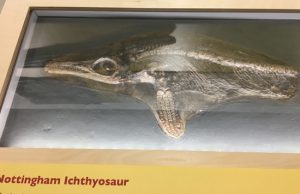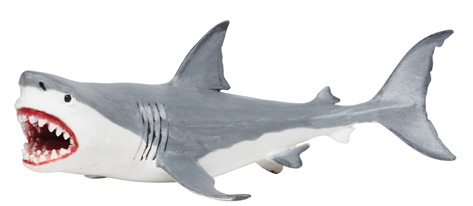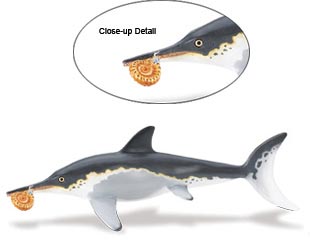Marine Reptiles – Dressed in “Little Black Numbers”
Study Suggests Some Marine Reptiles May Have Been Black in Colour
Although, technically “black” is an absence of colour, a study into the organic signatures of the hides of ancient marine reptiles indicates that these creatures may have been coloured black, or at least dark-skinned. The inability to detect evidence of other pigments does not necessarily mean that the likes of Mosasaurs, Ichthyosaurs and ancient marine turtles were all coloured black, but an intriguing report published in the scientific journal “Nature” sheds light on the possibility that extinct marine monsters could have been black or at least partially black.
Marine Reptiles
Recent research by vertebrate palaeontologists has provided an insight into the potential colouration of a number of extinct animals. Perhaps most notably members of the Dinosauria. Such research conducted by institutions such as Bristol University has opened up the possibility of pigments in preserved impressions of dinosaur skin being analysed (melanosome analysis) and some measure of colouration determined.
To read more about identifying the colour of dinosaurs: Ginger Dinosaurs?
The team of scientists from Lund University (Sweden) set out to investigate the potential colouration of marine reptiles, by examining fossils of a marine turtle, related to today’s extant Leatherback turtle along with the fossilised remains of a species of mosasaur (Tylosaurus nepaeolicus) and an Ichthyosaurus.
The Colouration of Extinct Marine Reptiles
Although these reptiles are only distantly related, they all represent organisms that evolved from terrestrial ancestors, at least according to most researchers, although the evolution of the Chelonia (tortoises, turtles and so forth) and how many times various branches of this particular reptilian family tree took to life in a marine environment remains open to speculation.
Under the guidance of one of the paper’s lead authors, Johan Lindgren (Lund University), the research team studied an early Jurassic ichthyosaur fossil (specimen number YORYM 993.338) dating from around 196 million years ago, along with the fossils of a Late Cretaceous mosasaur (Tylosaurus spp.) from around 86 million years ago (Santonian faunal stage) and the preserved remains of a distant relative of today’s Leatherback turtle (Eosphargis breineri) which dates from the Palaeogene – 56 million years ago.
Picture credit: Everything Dinosaur
Adaptive Colouration
Scientists know that adaptive colouration (the colour of organisms) plays many critical roles, from providing camouflage, to a visual display to attract a mate or to settle disputes amongst rivals, as well as to ward off potential attackers, or to indicate to any predator that they are poisonous or unpleasant to eat and so on. One of the most common pigments found in the animal kingdom is melanin. It too serves a multitude of functions including permitting dark colouration that helps cold-blooded animals regulate their body temperatures.
Black tends to absorb heat from the sun, much more efficiently than lighter colours which can reflect heat away. The higher absorption rate can help dark-skinned reptiles to warm up more quickly at the start of the day and retain heat for longer when the sun sets. For example, marine iguanas feed by diving into the cold sea that surrounds their Galapagos Islands home. Their black skins with large amounts of the biochrome (biochrome is another term for a natural pigment), melanin present help them to absorb heat quickly from the sun.
Scanning Electron Microscopes
In the study, the scientists used a scanning electron microscope to identify minute, traces of the shape of biochromes preserved within the fossil material. These “organic signatures” were then analysed using a highly sensitive spectrometer to assess the likely composition of the individual molecules preserved in the specimens.
Commenting on the findings of their research, Lindgren stated:
“The most sensational aspect of the study is that it can now be established that the analysed ancient marine reptiles were, at least partially, dark-coloured in life.”
Being dark in colour offers marine animals a number of advantages, especially if they are cold-blooded. Leatherback turtles can be found in relatively cold waters, certainly outside of the tropics. For example, these turtles, the largest turtle species in the world, have been sighted off the coast of Cornwall and further north up the Irish Sea in the height of summer. These turtles with their dark backs are known to bask at the surface, absorbing heat from the sun. Their colouration helps them to warm up quicker and to reach a higher body temperature.
Dark Traces of Soft Tissue
Such colouration might help these creatures exploit food sources in otherwise inaccessible habitats, they can extend their habitable range. The research team was able to demonstrate that dark traces of soft tissue preserved in the fossil material had large amounts of the degraded remains of eumelanin present, in intimate association with the fossilised melanosomes. The eumelanin, which is a naturally occurring, common form of melanin refracts light in such a way that objects appear dark brown or black. Based on this data, the scientists concluded that at least part of the turtle, the mosasaur and the ichthyosaur were coloured black.
In addition, in contrast to counter shading seen in many pelagic animals (pelagic – refers to an organism living above the sea floor), such as Great White Sharks, where the top part of the animal is dark contrasting with a lighter underside some types of ichthyosaurs may have been black all over.
Picture credit: Safari Ltd
The model above is from the 2014 releases by Safari Ltd. It represents a C. megalodon, an enormous, extinct shark. Scientists believe that this fish was an active hunter of the open sea and therefore the design team at Safari Ltd have given their replica classical counter shading of a nektonic (actively swimming) marine predator.
Note
Following a taxonomic revision most scientists describe this extinct shark as Otodus megalodon.
Identifying Biochromes
The detection method used failed to identify any notable amounts of other biochromes, notably ones responsible for yellow and red colours. This does not mean to say that scientists can rule out the possibility of yellow mosasaurs for example. These biochromes are perhaps less likely to survive the fossilisation process, they may also be present but not able to be detected given our current technology.
All that can be suggested from this study is that there is evidence to suggest that some types of ichthyosaur may have been dark coloured, whilst the mosasaur and the fossil Leatherback turtle provide evidence of these animals being dark coloured on the top parts of their bodies with perhaps lighter shading underneath (as seen in extant Leatherback turtles).
Evolutionary, behavioural ecologist Ted Stankowich (California State University) commented:
“While the presence of other undetected pigments cannot be ruled out, particularly dark pigmentation in these fossils suggests that they might have been able to live in more extreme environments or have used pigmentation patterns as camouflage in dark waters.”
Looking at extant Leatherback turtles, with their dark backs, the scientists suggest that dark pigmentation evolved separately amongst these ancient species which are not closely related. This could be a case of convergent evolution with different organisms evolving the same adaptive solutions to help them survive.
That is why the streamlined bodies of ichthyosaurs, superficially resemble modern-day dolphins. Ichthyosaurs and dolphins are not closely related but they have developed similar features. The dark pigmentation in these marine reptiles could have evolved to help regulate internal body temperatures, as protection against sunburn and camouflage.
Examining Turtles
Lindgren added that the ancient Leatherback turtle studied probably had a similar colour and lifestyle to extant Leatherbacks. Similarly, mosasaurs and ichthyosaurs may have benefited from their dark skins helping them to warm up between dives and to camouflage them in the darker depths of surface waters.
Other scientists are more cautious, asserting that care needs to be taken before jumping to conclusions based on limited sampling of the fossil record. Indeed, more needs to be learned about the benefits of dark colouration for extant marine organisms before too much can be inferred with regards to the inhabitants of ancient marine ecosystems.
A spokes person from Everything Dinosaur commented:
“This study extends our understanding of pigmentation preserved in the fossil record, beyond that of analyses related to proto-feathers and other examples of integumentation. However, if we take the Order Ichthyosauria (ichthyosaurs), this is a very diverse assemblage of marine animals. These highly successful reptiles evolved into a number of different forms, with different sizes, body shapes and methods of feeding. Although a uniform, dark colouration might be supported from the evidence of this study, this does not mean that all types of ichthyosaur were coloured black.”
Picture credit: Safari Ltd
Ichthyosaurus Pigmentation
The Ichthyosaurus pictured above from the Carnegie scale model collectibles range made by Safari Ltd. The design responsible for creating this 1:10 scale model of a “fish lizard” have intuitively given their replica a dark back. A team of researchers have postulated that a number of marine reptiles, including Ichthyosaurs may well have been dark coloured.
Knowing a little about the potential colour of an animal can give palaeontologists the opportunity to obtain information on how an animal might have lived, what particular ecological niche it was adapted to. These three disparate lineages of marine reptile (turtles, mosasaurs and ichthyosaurs), provide evidence of convergent evolution in the form of increased melanism. Based on extant examples, such as Leatherback turtles today, this study suggests that this colouration evolved to assist with thermoregulation and/or to help these creatures adapt to living in more extreme climate conditions such as much colder waters.
Marine reptiles sporting “little black numbers” as one of our colleagues referred to this study.
To view the range of prehistoric marine reptile figures in the Safari Ltd range: Wild Safari Prehistoric World Figures.




